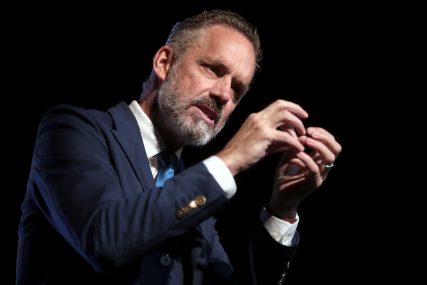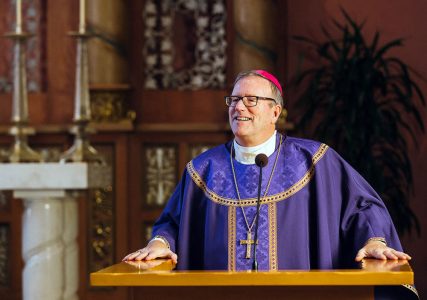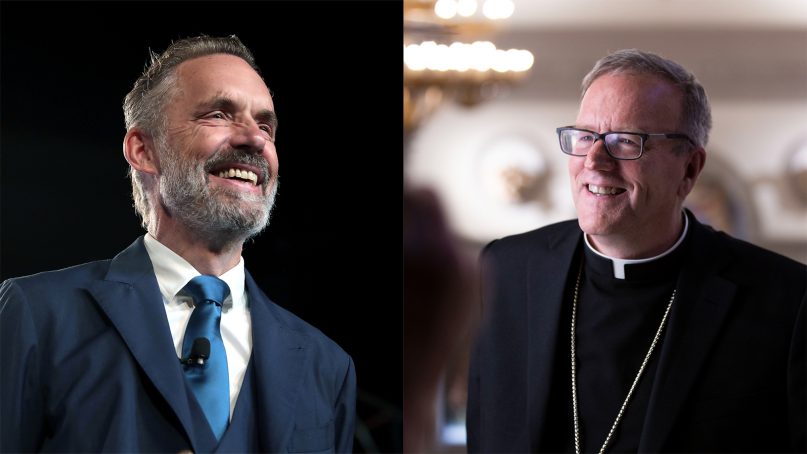(RNS) — At first glance, Jordan Peterson and the Catholic Church might seem like strange bedfellows. The Canadian psychologist and author of “12 Rules for Life: An Antidote to Chaos” is an existentialist and a materialist who puts his stock in the individual.
His argument that our social hierarchies are actually based in biology has made him a folk hero in some right-wing circles, where his adherents can be spotted by their T-shirts and ties bearing lobsters — whose hard-wired search for dominance, Peterson famously argues, we share.
It’s Peterson’s talent at spreading his ideas, especially among young people, that made him a topic of conversation earlier this month at the United States Conference of Catholic Bishops in Baltimore. The Rev. Robert Barron, an auxiliary bishop of Los Angeles whose Word of Fire Ministries focuses on evangelizing youth, praised Peterson’s effectiveness at using YouTube to connect with the religiously unaffiliated.
But this is not the first time Barron has allied himself with Peterson. Last year, Barron spoke positively about Peterson’s Jungian philosophy as an aid to restoring the Western intellectual tradition in a largely secular age.

Jordan Peterson addresses the 2018 Student Action Summit in West Palm Beach, Fla., in Dec. 2018. Photo by Gage Skidmore/Creative Commons
“The Jungian template enables Peterson to interpret many of the classical spiritual texts of Western culture in a fresh way — those very texts so often excoriated by mainstream intellectuals as hopelessly patriarchal, biased and oppressive,” the bishop said in a video on his own You Tube blog.
It’s not only the Western canon that Barron thinks Peterson is saving. “It’s especially valuable for the beleaguered young men in our society,” Barron said, “who need a mentor to tell them to stand up straight and act like heroes.”
Back in March of this year, Barron sat for a two-hour interview with Peterson on the latter’s podcast that will air later this month.
In the wake of Barron’s most recent comments, some liberal critics were quick to excoriate Barron, warning that Peterson — who has become increasingly popular in conservative circles for his open rejection of “political correction” — is a dangerously politicized figure whose views have been tainted by alt-right ideology. While Peterson has consistently disavowed his alt-right fanbase, it hasn’t stemmed his popularity or kept him from appearing with its most provocative luminaries, such as Milo Yiannopoulos.
But Barron’s willingness to embrace Peterson’s methods and general approach — if not Peterson’s materialist theological perspective — speaks to a wider trend within contemporary Catholic, and indeed Christian, American culture. More and more religious traditionalists are aligning with what might be termed “new atavists”: ostensibly secular opponents of contemporary “liberal” culture, who look to an imagined, mythical past for a glimpse of a better future.

Bishop Robert Barron. Photo by Doug Ellis, courtesy of Word on Fire
These new atavists share with their Catholic brethren a disillusionment with what they see as not just the disenchantment, but the feminization, of contemporary, post-feminist, post-sexual-revolution America.
Relatively mainstream figures like Peterson, as well as much more extreme members of online reactionary communities (check out, for instance, the men’s rights movement), harken back to pagan images and a rhetoric of primality: a world where men knew how to be men, and women knew how to be women — a world characterized by primordial battles between order and chaos.
These groups often celebrate atavistic (or faux-atavistic) practices like paleo dieting (Peterson famously eats nothing but beef) and intense weight-lifting, designed to transform men into the image of warriors or heroes.
In this, they often fall in with a certain brand of millennial faithful found on the loose internet forum Weird Catholic Twitter or similar theistic subgroups. These groups envision their religious identity as something consciously transgressive: a counter-cultural reaction to an increasingly secular world. To reject the (perceived) domination of “secular, liberal, feminist” values — as do both Catholic traditionalists and lobster-toting Petersonians — is to be, well, a little bit punk-rock.
Both new atavists and traditionalist Christians cast themselves as underdogs and as champions of meaning. Both characterize contemporary “postmodern” secular culture as rejecting inherent truth claims and grand narratives, and both groups in differing ways claim to be restoring a sense of meaning to the public square. Though they are divided by their biological determinism versus the Christian arc of salvation, they are fellow travelers in a sort of internal exile.
New atavists and religious traditionalists are increasingly aligning in online reactionary spaces. Just look at the very public conversion of Roosh V, the alt-right men’s rights activist, who announced in May that Christianity was, ultimately, the only viable cure to the “AIDS of modern life.”
In their farthest fringes, the new atavists keep company with white supremacist alt-right groups like the Crusades-era #DeusVult.
- Jordan Peterson addresses the 2018 Student Action Summit in West Palm Beach, Florida, in December 2018. Photo by Gage Skidmore/Creative Commons
- Bishop Robert Barron. Photo courtesy of Word on Fire
This is odd territory for a Roman Catholic bishop. Not that Barron is entirely wrong to laud elements of Peterson’s approach. The new atavists are bent on making traditionalism cool again, and in doing so they are turning the very elements of Christianity that millennials decry — that the faith is out of touch with contemporary life — into a feature, rather than a bug.
At their most effective, the new atavists have been able to provide a compelling aesthetic framework for a spiritualized counterculture, turning the rejection of the modern world and a willingness to question its mores and norms into a James Dean-style rebellion.
In so doing, they’ve provided an alternative, sought by many millennials, to uncritical acceptance of secular consumerist-capitalist culture. This is turf that Christians of all political leanings may well wish to explore.
The trouble here is that new atavists and their fellow-traveling Christians ultimately rest their assumptions on different metaphysical traditions. At their core, “new atavists” are Nietzschean materialists (a charge that could be leveled, too, at Peterson). They look to the past as a source of masculine, primordial strength: glorifying power and inherent biological hierarchies.
Christian theology, by contrast, rests on a subversion of that very hierarchy: on the narrative of a God who is at once the glorious king of the universe and the physically broken carpenter who finds that glory on the cross. It rests not on biological fact — reproduction, death and evolution of the powerful — but on a Resurrection that overcomes it.
Theology, then, not politics, is what makes Barron’s misty-eyed admiration for Peterson dangerous. The new atavists and Christian traditionalists may be effective allies now, but they’re going to have to part ways at the foot of the cross. If not, religious traditionalists may find themselves seduced by the power — and social media reach — of a theology fundamentally incompatible with their own.








